The Samsung SSD 830 Review
by Anand Lal Shimpi on September 24, 2011 1:02 AM EST- Posted in
- SSDs
- Storage
- Samsung
- pm830
- Samsung SSD 830
AnandTech Storage Bench 2011
Last year we introduced our AnandTech Storage Bench, a suite of benchmarks that took traces of real OS/application usage and played them back in a repeatable manner. I assembled the traces myself out of frustration with the majority of what we have today in terms of SSD benchmarks.
Although the AnandTech Storage Bench tests did a good job of characterizing SSD performance, they weren't stressful enough. All of the tests performed less than 10GB of reads/writes and typically involved only 4GB of writes specifically. That's not even enough exceed the spare area on most SSDs. Most canned SSD benchmarks don't even come close to writing a single gigabyte of data, but that doesn't mean that simply writing 4GB is acceptable.
Originally I kept the benchmarks short enough that they wouldn't be a burden to run (~30 minutes) but long enough that they were representative of what a power user might do with their system.
Not too long ago I tweeted that I had created what I referred to as the Mother of All SSD Benchmarks (MOASB). Rather than only writing 4GB of data to the drive, this benchmark writes 106.32GB. It's the load you'd put on a drive after nearly two weeks of constant usage. And it takes a *long* time to run.
1) The MOASB, officially called AnandTech Storage Bench 2011 - Heavy Workload, mainly focuses on the times when your I/O activity is the highest. There is a lot of downloading and application installing that happens during the course of this test. My thinking was that it's during application installs, file copies, downloading and multitasking with all of this that you can really notice performance differences between drives.
2) I tried to cover as many bases as possible with the software I incorporated into this test. There's a lot of photo editing in Photoshop, HTML editing in Dreamweaver, web browsing, game playing/level loading (Starcraft II & WoW are both a part of the test) as well as general use stuff (application installing, virus scanning). I included a large amount of email downloading, document creation and editing as well. To top it all off I even use Visual Studio 2008 to build Chromium during the test.
The test has 2,168,893 read operations and 1,783,447 write operations. The IO breakdown is as follows:
| AnandTech Storage Bench 2011 - Heavy Workload IO Breakdown | ||||
| IO Size | % of Total | |||
| 4KB | 28% | |||
| 16KB | 10% | |||
| 32KB | 10% | |||
| 64KB | 4% | |||
Only 42% of all operations are sequential, the rest range from pseudo to fully random (with most falling in the pseudo-random category). Average queue depth is 4.625 IOs, with 59% of operations taking place in an IO queue of 1.
Many of you have asked for a better way to really characterize performance. Simply looking at IOPS doesn't really say much. As a result I'm going to be presenting Storage Bench 2011 data in a slightly different way. We'll have performance represented as Average MB/s, with higher numbers being better. At the same time I'll be reporting how long the SSD was busy while running this test. These disk busy graphs will show you exactly how much time was shaved off by using a faster drive vs. a slower one during the course of this test. Finally, I will also break out performance into reads, writes and combined. The reason I do this is to help balance out the fact that this test is unusually write intensive, which can often hide the benefits of a drive with good read performance.
There's also a new light workload for 2011. This is a far more reasonable, typical every day use case benchmark. Lots of web browsing, photo editing (but with a greater focus on photo consumption), video playback as well as some application installs and gaming. This test isn't nearly as write intensive as the MOASB but it's still multiple times more write intensive than what we were running last year.
As always I don't believe that these two benchmarks alone are enough to characterize the performance of a drive, but hopefully along with the rest of our tests they will help provide a better idea.
The testbed for Storage Bench 2011 has changed as well. We're now using a Sandy Bridge platform with full 6Gbps support for these tests.
AnandTech Storage Bench 2011 - Heavy Workload
We'll start out by looking at average data rate throughout our new heavy workload test:

The SSD 830 manages to get within 13% of the SF-2281 based HyperX. While the old 470 couldn't really compete with the current generation of 6Gbps drives, the 830 holds its own. In the performance breakdown we see it's actually in the average read performance that the 830 falls behind. Its lackluster performance here is a bit surprising but given how well the SandForce drives perform it looks like the controller may just be getting bogged down by a bunch of IOs that SF just throws away, which in turn impacts its ability to deliver higher read performance.
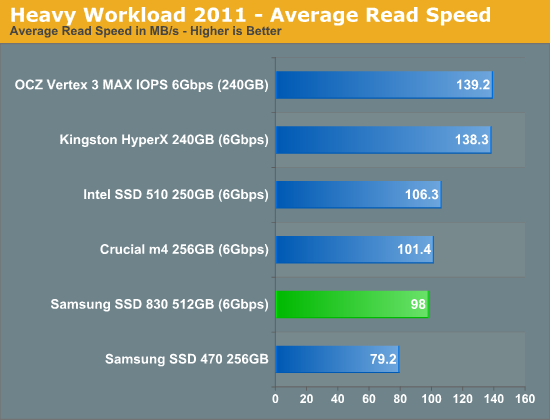
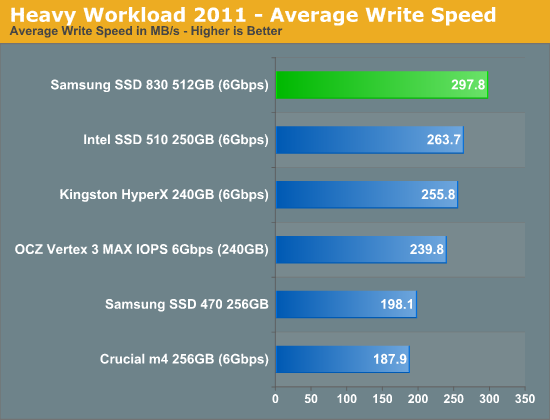
The SSD 830 actually does the best out of all of these drives when it comes to pure write speed. This isn't too surprising given how well the 830 performed in our incompressible sequential write test.
The next three charts just represent the same data, but in a different manner. Instead of looking at average data rate, we're looking at how long the disk was busy for during this entire test. Note that disk busy time excludes any and all idles, this is just how long the SSD was busy doing something:
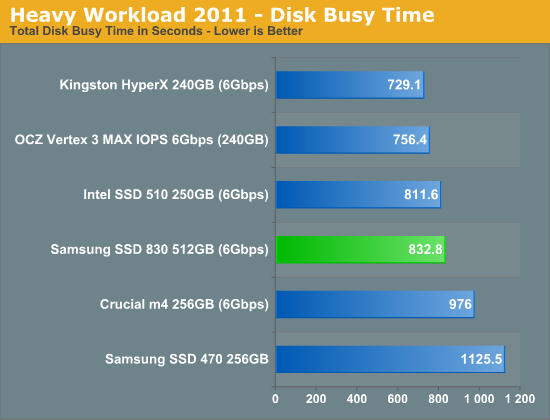
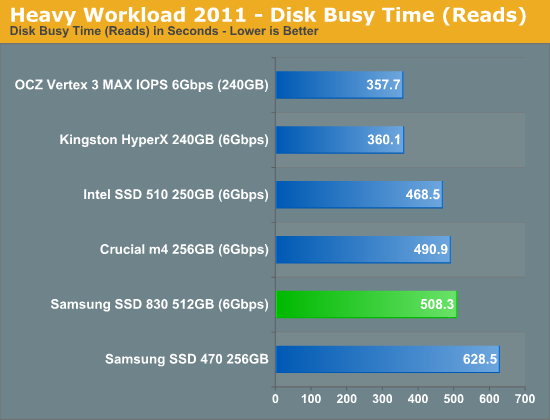
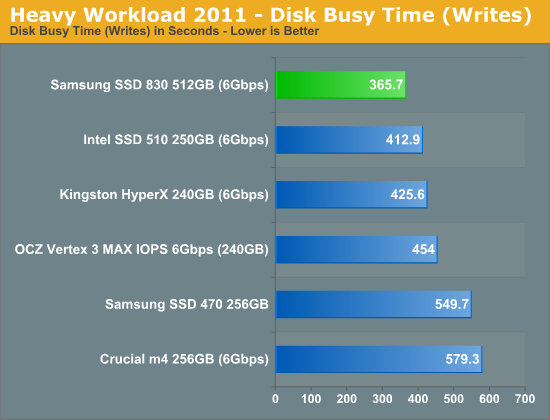










99 Comments
View All Comments
Out of Box Experience - Saturday, September 24, 2011 - link
Compatability?As far as I am aware, Intel and Samsung were the only drives compatible with XP and every other OS out of the box
Am I wrong on this point?
I believe ALL other SSD's require Partition Alignment for compatability
It would be nice to get an update to see if ANY newer 6Gbps are compatible with every OS out of the box like the Samsung 470 and Intel drives
Is there a compatability list floating around somewhere Anand?
A Google Search turns up no reliability issues from anyone who actually knows what they are doing either
If you want to find hundreds of reliability or compatability issues, just visit the OCZ Forum or go read the Newegg reviews
or go sleep it off
extide - Tuesday, October 4, 2011 - link
EVERY SSD should be 4KB aligned for best performance.Out of Box Experience - Wednesday, October 5, 2011 - link
Intel and Samsung SSD's do not require end user alignmentOnly SSD's that do not have the offset in firmware require alignment
kake - Saturday, September 24, 2011 - link
I like your mic.sequoia464 - Saturday, September 24, 2011 - link
Quite a bit more juice running through them than the other drives - is this partly from the 256 mb cache?tipoo - Saturday, September 24, 2011 - link
Even the most power hungry SSD's don't require any additional cooling. It may look big on the graph, but that's still sucking way less power than most things in your system like the processor, graphics chip, etc. It just won't produce that much heat.sequoia464 - Saturday, September 24, 2011 - link
Thanks, Reason I asked is that My Toshiba based Kingstons seem to run (at least to the touch ) cooler than my both Intels and Vertex2's. (not that they are hot by any means, just warmer).Probably the workload and usage that is at play here - now that I think about it.
name99 - Saturday, September 24, 2011 - link
Different people have different concerns.Yes, if you install this in a desktop box power is not an issue.
If you install it in a laptop, the concern is probably not the thermal load but the maximum power draw. If your laptop is not specced to handle that, you'll find the machine crashing when you do a lot of back-to-back writes.
Same thing if you hoped to use it in a USB enclosure, whether USB2 or 3.
Jaybus - Tuesday, September 27, 2011 - link
Probably a combination of things. Certainly, the DRAM is much larger than what is used by the other drives. Also, notice that this 512 GB version is being compared to 256 GB drives, so right off the bat its flash is taking twice the power as those it is being compared with. This was mentioned in the article. Samsung has not yet supplied a 256 GB version for testing. So I doubt it is a controller issue. Probably just the fact that it has twice the flash.infini - Saturday, September 24, 2011 - link
I don't think Intel is the king of reliability with the 8mb problem of the 320 series. Beenthere can you provide a link with compatibility and reliability problems of Samsug drives?